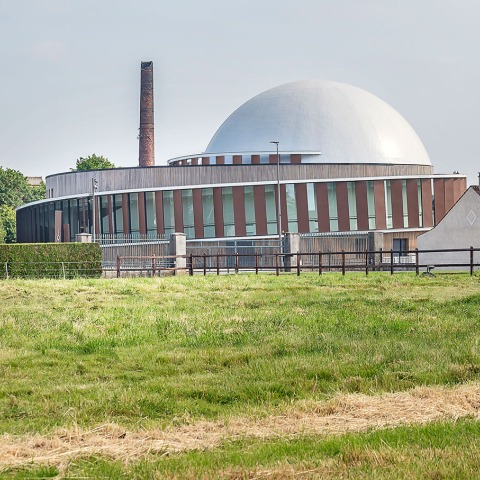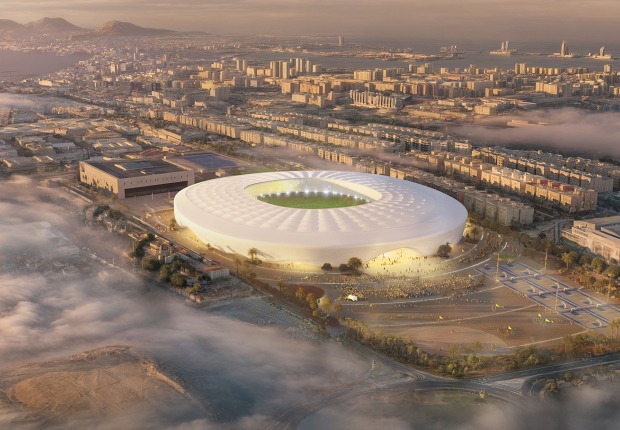The project seeks to maintain continuity with the landscape by proposing a plant cover. The exterior finishes of the building show a dialogue with the construction systems used in the region using materials from nearby buildings.
The lower level deck near the neighboring parcels is vegetated, adding a natural element that helps integrate the project into the existing site landscape. The dome of the projection room is covered with a light gray PVC membrane, which reduces its visual impact and improves the path of the ramp that winds around the façade.
In the project, importance is given to sustainability, which is why geothermal energy is supplied, which is used for both hot and cold seasons, and an intelligent natural ventilation system is also implemented.

Orionis by Snøhetta. Photograph by Jad Sylla.
Description of project by Snøhetta.
Situated on a remarkable site, between the adjacent Scarpe River, the archaeological museum Arkéos and a nearby residential complex, the project aims to harmoniously connect these elements and create an accessible and inspiring space for visitors. Snøhetta’s design is a unified building with curves that wrap around the two domes of the projection room and the observatory.
"The Planetarium is one of the first projects to be completely conceived, managed, and built by Snøhetta’s studio in Paris. We are extremely excited to showcase the Snøhetta approach for delivering high-quality cultural and educational buildings in France".
Oliver Page, Managing Director of Snøhetta’s studio in Paris.
In close collaboration with CET Ingénierie, Impact Conseil et Ingénierie, Cicanord, Studio Dap, and Atelier Silva Landscaping, Snøhetta has been working on the building since late 2019, seeing the project through from concept to construction. Orionis opened to the public on the 13th of May 2023.
Ellipse - a timeless and fluid concept
“We wanted to propose an extraordinary meeting place and a new destination for the inhabitants of Douai. The architectural and urban concept of our project takes its inspiration from the elliptical movement of the stars. Being continuous, fluid, and perpetual are notions that we have reinterpreted in the project, not only in terms of the shape but also in the experience that visitors will have of the planetarium, all senses employed”.
Explains Kjetil Trædal Thorsen, co-founder of Snøhetta.
The concept of continuous movement has inspired the project throughout, defining everything from the reception area, the exhibition spaces, the amphitheater, and the domes of the building. The building is linked by a slightly inclined ramp, visible from the outside through the building’s partly translucent façade.

Orionis by Snøhetta. Photograph by Jad Sylla.
Integrated into the local environment
The notion of timelessness is also found in the continuous movement of the Scarpe River and the surrounding landscape that weaves a physical and visual link to the planetarium. It is designed to integrate seamlessly with the Arkéos Museum and shares landscaped areas and parking lots intended to connect these two cultural entities.
The two domes aim to be a visual signal that can be seen from afar while not impacting the local neighborhood. Snøhetta’s goal was to reveal the building’s program and function from the exterior through its shapes.
Linking landscape to its surroundings
The design of the outdoor spaces has two distinct characteristics; the surrounding landscape and an elliptical interior courtyard. Both help to create a coherent and contextualized cultural destination that takes advantage of the outstanding features of the site while integrating seamlessly with the surrounding landscape.
The landscape is designed to promote biodiversity and integrates the materials present on the site. The garden has a continuous pathway that connects various outdoor spaces and the building. The path is paved with natural bluestone from Belgium, providing an additional layer of texture and visual expression. Also, plants and trees are strategically placed to integrate the parking spaces and the forecourt.

Orionis by Snøhetta. Photograph by Jad Sylla.
The roof is planted with wild grass, creating a natural and organic visual element that is highly visible inside the building.
Once inside the building, the planted and glazed patio is visible from all interior spaces and works as a calm outdoor space, providing a connection to the natural landscape outside.
Users at the heart of the project
The design of the building addresses the needs of the many users maintaining a sense of coherence and continuity with the overall theme of the planetarium.
The visitor circuit flows smoothly from the entrance, through the gift shop and exhibition space, all the way to the immersive room. Then, the ramp gently brings the audience back down to the ground floor and towards the exit.
Specific areas have dedicated access to ensure that the flows do not intersect, such as the observatory area and offices on the first floor.

Orionis by Snøhetta. Photograph by Jad Sylla.
Materiality a key element
The planetarium's exterior envelope is inspired by the surrounding region and the materials used in nearby buildings such as the Arkéos Museum and brick houses. The project is composed of three main colors: the evolving wood color of the poplar, the rust color of the steel brise-soleils, and the light gray PVC membrane that covers the dome of the projection room.
The color of the steel panels in front of the curtain walls on the main façade and wood siding, both inspired by the Arkéos Museum, contribute to a cohesive design that blends with the environment.
The roof of the lower level near the neighboring parcels is vegetated, adding a natural element that helps integrate the project into the existing site landscape. The screening room dome is covered with a light gray PVC membrane, reducing its visual impact and enhancing the path of the ramp that winds around the façade.
Sustainability ambitions
Sustainability played an important role in the design of the project. The heating for the showroom's floor is supplied by geothermal energy, and it provides heating for the building during the winter and cooling during the summer. Additionally, sensors are installed on multiple openings to allow for intelligent natural ventilation. Finally, the sunshades and the green roof also contribute to responsible regulation of the building's temperature and rainwater. Locally sourced materials were preferred to limit the carbon footprint and allow for a low environmental impact construction site.



















































